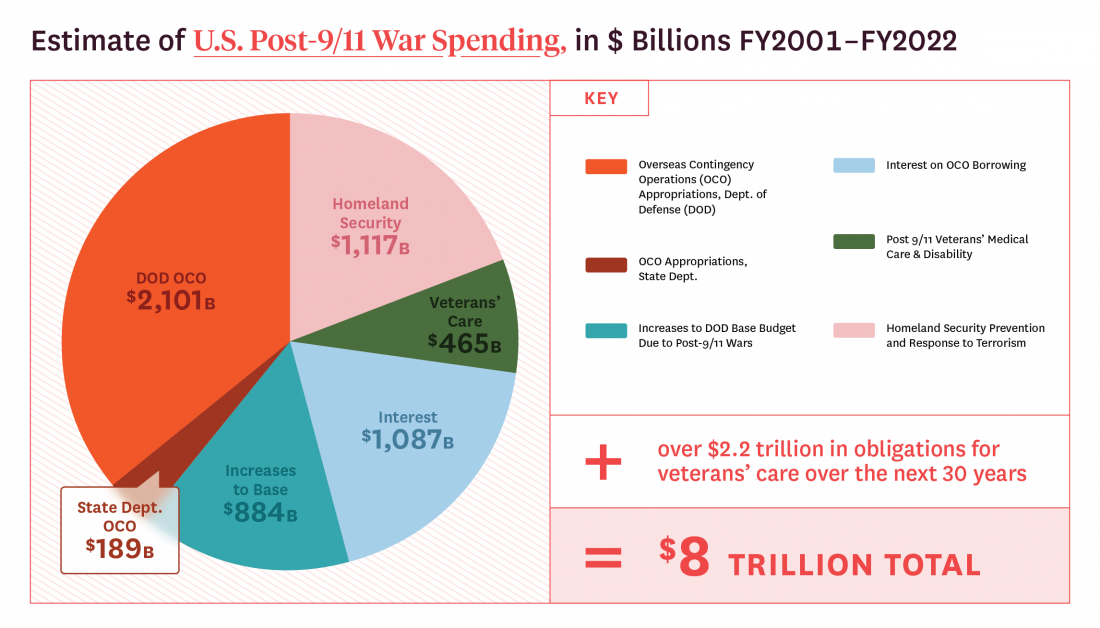Macroeconomic Impact

Data from The United States Budgetary Costs of Post-9/11 Wars (2021) by Neta Crawford.
Since late 2001, the United States has appropriated and is obligated to spend an estimated $8 trillion through Fiscal Year 2022 in budgetary costs related to and caused by the post-9/11 wars — an estimated $5.8 trillion in appropriations in current dollars and an additional minimum of $2.2 trillion for U.S. obligations to care for the veterans of these wars through the next several decades.
Of the $8 trillion total, about $2.3 trillion have been spent on what used to be called the “Global War on Terror” and is now referred to as “Overseas Contingency Operations.” Over $1 trillion has been spent on interest payments to pay for the post-9/11 wars, since these have been funded entirely through debt. The base budget of the Pentagon has increased by about $900 billion above what it would have been in the absence of war; Homeland Security spending on preventing and countering terrorism has totaled over $1.1 trillion since the inception of the Department of Homeland Security in 2002; and current and future costs for veterans has added nearly $2.2 trillion to the costs of war and that figure will continue to grow.
An important macroeconomic impact of federal spending on the Iraq and Afghanistan wars has been to raise the nation’s indebtedness. The increased military spending following 9/11 was financed almost entirely by borrowing. Rising deficits have resulted in higher debt, a higher debt-to-GDP ratio and higher interest rates.
Since the post-9/11 wars have been funded almost entirely by debt, and the U.S. public debt continues to grow, the costs of interest payments continue to accumulate. Even as the wars cease, interest will continue to accumulate and will reach several trillions of dollars over the next several decades. The effect of rising debt and growing interest payments is not only the increase in interest rates, which affects both the public and private sectors, but also constrains future spending decisions. The Congressional Budget Office estimates that net interest payments are currently about 1.4 percent of the GDP and are expected to rise to 2.4 percent by 2031 and 8.6 percent by 2051. As interest payments account for a greater share of the federal budget, opportunities to spend federal dollars on productive investments — clean energy, infrastructure, education, and so on — are constrained. Rising debt and interest costs also contribute to generational inequality, as they are burdens passed along to future taxpayers.
The costs of the post-9/11 wars, as well as the increase in payments to military contractors, have both increased federal spending on defense. Defense spending accounts for more than half of all discretionary spending; the total is closer to 2/3 once the Department of Homeland Security and Veterans Affairs are included. And of defense spending, more than one half is channeled to contractors. Costs of War analysis finds that this raises costs, rather than reducing them, as contractors often have monopoly-like conditions or contract specifications that minimize cost savings and increase profits at the taxpayers’ expense.
Key Findings
-
The post-9/11 wars have cost the U.S. at least $8 trillion and rising since 2001.
-
War spending has been funded almost entirely through debt, which increases the debt/GDP ratio and the interest rate.
-
Interest costs of the post-9/11 wars now surpass $1 trillion and will reach several trillion more over the coming decades.
-
Rising interest payments crowd out future opportunities for federal spending and increase the debt and tax burden for future generations.
-
Over half of discretionary spending is for the Department of Defense, and over half of that spending has in recent years been for contractor.
(Page updated as of September 2021)

